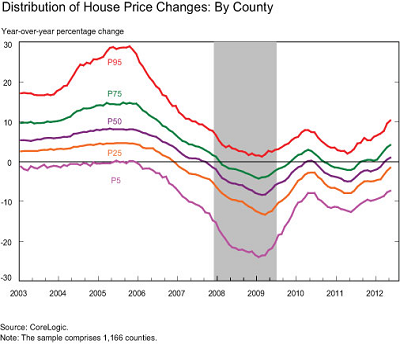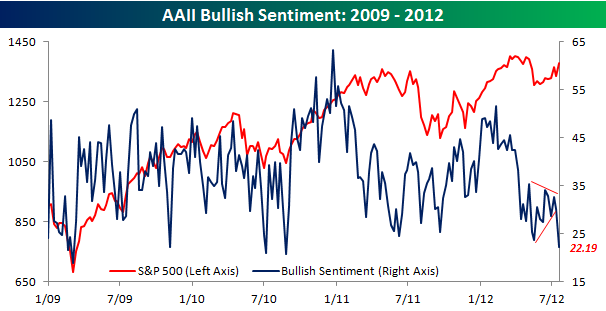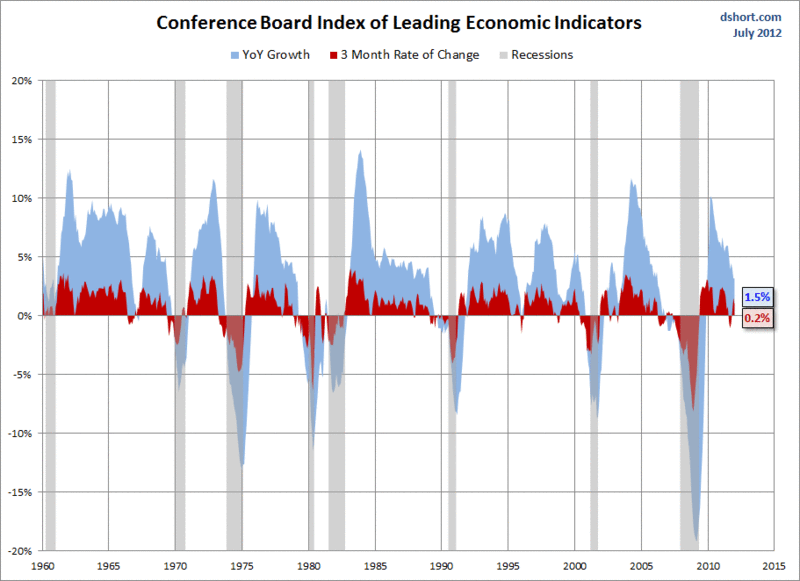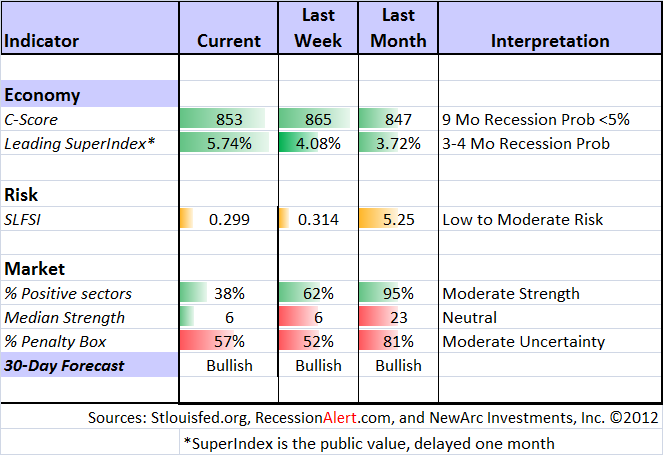After the volatility of last week's "three-ring circus," I expect a quieter trading week. Based upon evidence from somewhat weaker economic reports and lower corporate revenues, the key question is: How big is the economic slowdown?
It has taken only a slowing in the rate of growth -- not a decline -- to convince many that a new recession is upon us. This is a key question, and we'll have more evidence this week.
I'll offer my own expectations in the conclusion, but first let us do our regular review of last week's news.
Background on "Weighing the Week Ahead"
There are many good sources for a list of upcoming events. With foreign markets setting the tone for US trading on many days, I especially like the comprehensive calendar from Investing.com. There is also helpful descriptive and historical information on each item.
In contrast, I highlight a smaller group of events. My theme is an expert guess about what we will be watching on TV and reading in the mainstream media. It is a focus on what I think is important for my trading and client portfolios.
This is unlike my other articles, where I develop a focused, logical argument with supporting data on a single theme. Here I am simply sharing my conclusions. Sometimes these are topics that I have already written about, and others are on my agenda. I am putting the news in context.
Readers often disagree with my conclusions. Do not be bashful. Join in and comment about what we should expect in the days ahead. This weekly piece emphasizes my opinions about what is really important and how to put the news in context. I have had great success with my approach, but feel free to disagree. That is what makes a market!
Last Week's Data
Each week I break down events into good and bad. Often there is "ugly" and on rare occasion something really good. My working definition of "good" has two components:
- The news is market-friendly. Our personal policy preferences are not relevant for this test. And especially -- no politics.
- It is better than expectations.
It was, as expected, a busy week for news and data.
- More signs of a bottom in housing. The NY Fed (analyzed by GEI) and a good analysis of potential GDP impact from Reuters. Housing starts are up 40% YoY (Scott Grannis - see chart).

- Bullish sentiment "falls off a cliff" according to Bespoke. This is a short-term market positive.

- Corporate earnings have been beating (lowered) expectations, much as we have expected. Some major companies (especially GE) have given relatively positive outlooks, despite the expectation that most would be conservative.
- Rail and sea traffic are positive. See Steven Hansen's articles (Rail, Sea). Ports of LA and Long Beach are building at a "furious pace." (Calculated Risk).
There was plenty of negative news from our three-ring circus last week.
- Bernanke's testimony showed no immediate inclination for more stimulus. Since traders are more skeptical about the economy than is the Fed, this caused instant, but temporary, selling.
- Corporate revenues (contrast with earnings above) are worse than expected. My colleague Scott Rothbort at Wall Street All Stars writes an excellent daily column. He notes that the weaker dollar helps costs and hurts revenue for many companies. This seems to have escaped the notice of less discerning analysts.
- Earnings expectations for 2012 are still declining. Brian Gilmartin tracks this carefully at his new blog -- highly recommended.
- Conference Board Leading Economic Indicators moved lower. Their interpretation is that the economy has a steady but soft pace while sailing through "strong headwinds." Doug Short has a good analysis and an interesting chart showing the rate of change in this index and past recessions.

- Initial jobless claims spiked higher, back to the 180K range, reflecting the auto company seasonality. This suggests that last week's improvement was a one-time effect.
- Fiscal cliff rhetoric is bad. No sign of progress before the election.
There was a lot of ugly stuff happening last week, but I want to stick to the world of investments. The most dangerous thing for the individual investor right now is the apparent safety in the quest for yield. I warned a month ago that investors should build a ladder from individual bonds rather than owning funds. Many will be surprised by actual losses from their bond funds, despite the past performance.
I was delighted to read Barry Ritholtz's fine article in the Washington Post, also recommending a bond ladder approach and warning about some alternatives. This is important and deserves the visibility before it is too late.
In "Con Job," Tom Brakke shows how apparent high-yielding funds are really giving investors their own money back in the guise of yield. Check out the great chart.
The Indicator Snapshot
It is important to keep the current news in perspective. My weekly snapshot includes the most important summary indicators:
- The St. Louis Financial Stress Index.
- The key measures from our "Felix" ETF model.
- An updated analysis of recession probability.
The SLFSI reports with a one-week lag. This means that the reported values do not include last week's market action. The SLFSI has moved a lot lower, and is now out of the trigger range of my pre-determined risk alarm. This is an excellent tool for managing risk objectively, and it has suggested the need for more caution. Before implementing this indicator our team did extensive research, discovering a "warning range" that deserves respect. We identified a reading of 1.1 or higher as a place to consider reducing positions.
The SLFSI is not a market-timing tool, since it does not attempt to predict how people will interpret events. It uses data, mostly from credit markets, to reach an objective risk assessment. The biggest profits come from going all-in when risk is high on this indicator, but so do the biggest losses.
The C-Score is a weekly interpretation of the best recession indicator I found, Bob Dieli's "aggregate spread." I'll explain more about the C-Score soon. We are working on a modification that will make this method even more sensitive. None of the recession methods are worrisome. Bob also has a group of coincident indicators. Like most of the top recession forecasters, he uses these to confirm the long-term prediction. These indicators are also not close to a recession signal.
There is a lot of activity from the recession forecasters. The basic summary is that those with the best records still see little chance of a recession in the next six months or so. The people that get featured in the press and on TV are sticking by their guns, even though the evidence is mounting against them.
We are now at the end of the nine-month forecast window that the ECRI adjusted to after their September, 2011 call (recession imminent, maybe already here, and unavoidable) seemed to prove wrong. Since then they have been adjusting indicators and trying to extend the window, which supposedly ends right now -- mid-year 2012. Instead of agreeing to this, the ECRI has now raised the notion that there is already a recession, but it has not yet been recognized. For the last two weeks there have been numerous refutations of this claim. Meanwhile, I recommend this article where I did a rather comprehensive list leading up to last week and also my new Recession Resource Page, which explains many of the concepts people get wrong.
I'll have more on the most recent work in this week's conclusion.
The single best resource for the ECRI call and the ongoing debate is Doug Short, who has a complete and balanced story with frequent updates. 
Our "Felix" model is the basis for our "official" vote in the weekly Ticker Sense Blogger Sentiment Poll. We have a long public record for these positions. This week we continued as "bullish," although it is a pretty close call. These are 30-day forecasts.
[For more on the penalty box see this article. For more on the system ratings, you can write to etf at newarc dot com for our free report package or to be added to the (free) weekly ETF email list. You can also write personally to me with questions or comments, and I'll do my best to answer.]
The Week Ahead
There are a number of minor releases this week, including some regional Fed surveys. The biggest items are the following:
- New home sales on Wednesday, since there is plenty of interest in potential housing growth.
- Initial claims (Thursday) especially given the recent wild fluctuations.
- Durable goods orders (Thursday).
- Advance GDP estimates for Q2 (Thursday). This is important even though it is backward looking and will be subject to significant revisions.
Our trading positions continued in fully invested mode last week. Felix is not a range trader, but is excellent at getting on the right side for big moves.
Investor Time Frame
The successful investment strategy differs markedly from trading. It is especially important to establish good, long-term positions when prices are favorable. Most individual investors seriously underperform long-term results by selling low and buying high. Most successful professionals, of course, do the opposite.
This is easier said than done. With everyone on TV explaining with great confidence what just happened (please check out my article on the "message of the markets") it is easy for the average person to think he is out of step.
There is no magic moment. Resolving market worries is a process, not an event.
I tried to explain the most important concept for individual investors in this article about the Wall of Worry. I have had many emails from people who had a personal breakthrough in their investing when they understood this concept. If you missed it, I urge you to take a look. You can contrast this with the many pundits who claim miracles of market timing.
The market action last week, once again illustrated market moves based on little change in the underlying information, especially after Bernanke's testimony.
The best strategy through the various gyrations has been buying dividend stocks and selling calls for enhanced yield. Anyone unhappy with bonds should be doing this for a yield of 8-10% with greater safety than pure stock ownership. Take what the market is offering!
Those who had calls expiring worthless last Friday can now do a new round of sales.
Final Thoughts on the Slowdown
The recession forecasts have a lot of traction, despite the lack of supporting data. I was reminded of the attraction of intuition by the continuing comments of golf analyst Curtis Strange, talking about the "heavy air" at the British Open. This seems plausible to most, but is actually wrong. Humid air is less dense than dry air, and in the absence of other variables, humidity adds slightly to distance.
You cannot get a bet down on that error, but you can act on the misleading recession forecasts.
Many people confuse continuing below-trend growth with a recession. As investors, we are interested in the effect on corporate earnings and stock prices, both of which have done well despite the sluggish recovery. A recession starts at a business cycle peak. A slowing rate of growth does not signal a peak. This is completely counterintuitive, so it makes the average person vulnerable.
It is in the interest of many to promote the recession talk:
- The "out" party (and Dems would and did do the same thing when they were out);
- The media (selling page views and ratings);
- Those who have made a big reputational play (like the ECRI); and
- Those selling fear and gold.
There was even more excellent work this week on the recession front, all featuring solid quantitative work.
The Bonddad Blog looked at initial jobless claims before past recessions and found little evidence that current circumstances are similar.
Dwaine van Vuuren looks specifically at the four main indicators used by the NBER in determining the start of recessions. This is different from the recession forecasting model he has developed, since it is more of an analysis of current conditions, what he calls a "confirmation of last resort." Most will need to read the article carefully, but the verdict should be pretty clear.
Doug Short also looks at the big four indicators. As usual, he has many helpful charts showing quite clearly the difference between current conditions and past recessions. The entire article is great, and recessionistas should study the charts carefully. Here is one that summarizes the key elements: 
Here is Doug's answer to his own question of whether the Big Four are rolling over:
"As of the latest data, no, they are not collectively rolling over. Here is the big picture since 1959, the same chart as the one above, but showing the average of the four rather than the individual indicators. This chart clearly shows the savagery of the last recession. It was much deeper than the closest contender in this timeframe, the 1973-1975 Oil Embargo recession. While we've yet to set new highs, the trend has collectively been ever upward."
Investment Conclusion
Most investors spend too much energy trying to form their own conclusions about the economy. I am surprised by the strong feelings I see in comments, emails, and private conversations.
Unless you have your own macroeconomic model and plenty of experience, you have no basis for your personal opinion about recessions.
Unless you have significant experience in evaluating quantitative models, you have no basis for choosing among the various expert forecasts.
I do not have a macro model, but I try each week to help people find the best experts in various fields. There will eventually be another recession, of course, but the evidence is not there yet.
